
Most dogs don’t like to see their owners leave home. However, some dogs suffer an extreme reaction when their “people” are gone due to a condition called separation anxiety. This anxiety can result in the destruction of the household while owners are away and even self-injury for the dog. Luckily there are ways to prevent and treat your dog’s separation anxiety.
The most important thing for pet owners to remember about separation anxiety is that it has nothing to do with a lack of obedience, training, or love. Separation anxiety has to do with panic that your dog feels at your departure or absence. Therefore, their response is distress, which often leads to destructive behavior.
Dogs have limited means of communicating to us how they feel physically and emotionally. It’s up to the responsible pet owner to pay close attention to their dog’s behavior, especially if it is outside normal expectations. Underst anding the signs of separation anxiety in your dog and how to treat the condition can ease stress for both of you.
Separation anxiety generally presents in dogs who are very attached to their family members. Dogs that suffer from separation anxiety are known to “shadow” their owners and rarely spend time by themselves, requiring a significant amount of attention or physical contact.
Separation anxiety has nothing to do with a lack of obedience, training, or love.
Pet Travel Center (pettravelcenter.com)
However, the problem with separation anxiety in dogs is what happens when they are not with their owners. As a result of fear, panic, and distress at being separated from their human(s), these pups will often engage in destructive behaviors while home alone—which, in severe cases, could even lead to self-harm.
It’s difficult to know why some dogs suffer separation anxiety, and others don’t. It could be from a previous traumatic event, change in schedule, or just a lack of human contact. No matter the cause, it’s crucial for pet owners to recognize the signs of separation anxiety to treat it in their dog.
Some commons signs of separation anxiety are:
Your dog may not exhibit all these behaviors and they may not exhibit them with every separation. In addition, some dogs do suffer from boredom or occasional accidents when left alone for long periods of time. However, if your dog is consistently showing these symptoms of distress, it’s important to determine if the cause is separation anxiety and how to alleviate it.

The first step in treating separation anxiety should be a visit to your veterinarian. Though your vet may not be able to diagnose this, they will certainly recognize signs of distress and potentially eliminate any underlying medical causes for such behavior.
Whether your dog’s separation anxiety is severe or not, here are some important techniques to try as a means of alleviating this condition:
To treat separation anxiety, it’s important to choose methods that don’t make your dog feel isolated or punished.
Pet Travel Center (pettravelcenter.com)
For dogs with very severe separation anxiety, it may benefit you as a pet owner to keep them in a particular room while you are temporarily gone. However, it’s essential that this room be spacious with toys and a window, so they don’t feel isolated or punished. Also, your dog should always have access to fresh water and food if necessary.
As for how to cope with your dog’s separation anxiety as a human, it’s essential to underst and that your pup doesn’t want to feel or act on such anxiety. Therefore, turning to punishment, obedience training, crating, etc., will not help the situation. Instead, it may be wise to consider a “doggie daycare” or hiring someone to pay frequent, regular visits to your dog during the days you are absent. Some vets may even prescribe an anti-anxiety regimen.
As a pet owner, you should never associate a dog’s separation anxiety with a lack of love. If anything, your dog suffers from this condition because of how much they love you and want to be with you. Patience, underst anding, and careful techniques are instrumental to treat your dog’s separation anxiety.
Uwe - 30 Sep 2020, 03:01
This is really interesting. I think my puppy has seperation anxiety.
Sheryll - 5 Sep 2020, 03:36
Really good article. My chihuahua has separation anxiety now I know how to deal with it.